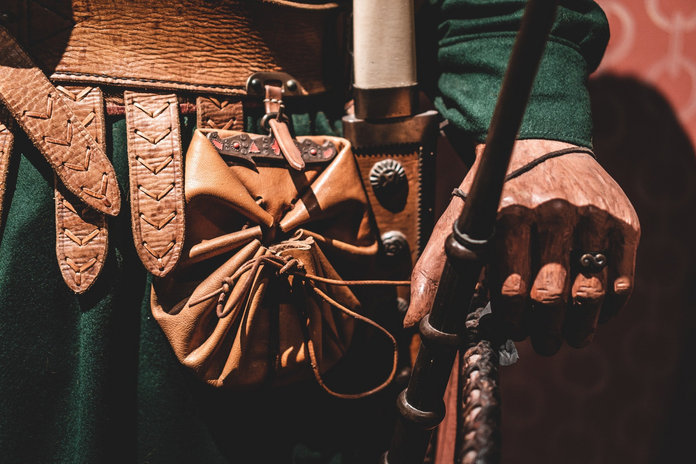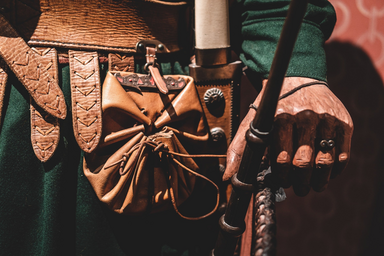Some time ago, I wrote about historical fashion fads that in their time were considered exciting but would nowadays seem…rather bizarre. Read part 1 here and part 2 here. As a sort of continuation to the series, I am now taking a closer look to some Medieval trends, most of which are actually quite cool!
We all know that fashion repeats itself – clothing that was stylish twenty years ago comes back with a bang. Some things never escaped fashion in the first place. But what about the Middle Ages? Medieval style fantasy has been in vogue for quite some time and there is also a vibrant fanbase for all things Middle Ages. But is there something we could learn from the actual medieval fashion? Let’s take a look!
- Commoner’s Guide to Basics
-
Short tunic and hose – sort of long socks reminiscent of today’s hosiery were a lasting base of men’s clothing through late Antiquity to the 17th century. Both common folk and the rich used variations of this style. As the tunics and jackets got shorter in time, a gap formed between the hose and the jacket. And as it were, people didn’t want everyone to see their underpants (a.k.a. braies), so the hose were sewn together along the crotch area and pants (well, pantyhose) were born. Yes, the pants as we know today in European fashion and all around the world used to be socks. Rad.
The knight in the picture is the Biblical character Goliath, who is wearing a hauberk, a shirt consisting of small metal rings tightly linked together. On top of that is a red outerwear, surcote, the function of which is mainly heraldic, but possibly also protective. As one would guess, this type of armor wasn’t the most effective against later, heavier arms like crossbow, and was thus replaced by a tougher suit of armor in the 15th century.
- Medieval Chilling
-
Regardless of what is happening in this scenario, it is a good depiction of 13th century – early 14th century fashion fads. Women started to expose their hair in the deep Middle Ages, although in some parts of Europe married women continued to veil their hair to the end of the Medieval times. The woman is wearing a barbette under her chin, holding in place the linen headpiece. (Do you remember the time when wearing something under your chin was fashionable? Me neither.) Tight sleeves are seen from underneath the pinkish surcote – a must-have item from the 13th century onwards.
The young man has short, curled hair – beard was out of fashion during the time period of the work shown here, so the features are quite clean and boyish. That’s nice.
- Fortune Favors the Fashionable
-
This allegorical figurine of the Fortune is wearing an exquisite surcote with beading and precious stones. Surcotes didn’t have an actual shirt-piece, as seen here, they are open on the sides and reveal the tightly woven underdress or cote-hardie. From the 12th century onwards, it became fashionable and – up to certain degree – acceptable for people in western Europe to wear clothing that was so closely fit it revealed the shapes of the wearer’s body. The hip was elegantly showed forward when women were walking – it was both fashionable and implied fertility.
Some extreme “fashion phenomena” became also known during the Middle Ages, for example the sort of sleeve extensions seen in this picture – seemingly meaningless narrow strips of fabric that continue all the way to the ground and can be playfully tied around different body parts.
- Cool Places to Hide Stuff In
-
No matter what, medieval hats and head pieces were cool. First men wore shoulder hood with a long “tail” in the back. The hood became a hat, as it was subsequently raised above the head and tied and arranged in the most fashionable way. Some of the men standing in the lines are depicted with this style, as well as the French king in the next picture. Two of the men in the group are wearing what seems to be a green medieval style straw hat.
Preacher John Ball, on horseback, is rocking another version of the long-tailed hood, most likely chaperon. He is also carrying a leather purse on his belt, just like another man in the foreground. This was a cool and clever way to carry your belongings with you for both men and women. People could also take advantage of the sleeve trends and carry important items in their huge sleeves.
- Swish Swash Go the Houppelande Sleeves
-
This picture shows Charles VI of France, wearing a magnificent dark houppelande over a green undershirt. The houppelande dress – worn by both men and women, was meticulously tied with a belt so that it settled beautifully all the way to the ground. The sleeves are especially huge, here lined and backed with animal skin. Brown Sable and marten were expensive, imported to Europe from Russia. The person in the far left is rocking a houppelande or a pellanda with beautiful decorative cuts on the sleeves.
- For the Love of Music and Colors
-
Mi parti -style was all the rage among young men in the mid-14th century. In this picture, several troubadours are wearing the style as each side of the long robes are of different, colorful fabric. The robe of the person in the middle is lined with animal fur, which became all the more important and trendier in the 14th century, when the Little Ice Age began to lower the mean temperature in Europe for centuries to come. The wide sleeves of the fashionable robes, worn by some of the troubadours here, demonstrate that the more extravagant houppelande was on the way.
We can safely say that the medieval people loved colors, although the colors in most of the artwork are likely imaginary. Common people could afford to dye some of their clothing, but colors like red and purple were expensive and difficult to achieve. Blue and yellow, however, were popular dyes and came from natural plant sources, such as woad and dyer’s weed. Other popular colors were natural linen, black and brown. Noble and rich people could adorn their clothing and shoes with embroidery and later with more detailed fabric patterns as advanced weaving techniques became more common.
As we all should know by now, Middle Ages were not stagnant. Actually, one could claim that fashion trends, as we know them today, were born somewhere close the 14th century. The methods of making clothes and accessories improved. As the clothes became more sophisticated, the variation in styles, possible colors, fastening and sewing techniques increased, and made possible the “seasonal” changes, showing off, and mimicking of trends and styles. So once again, we could claim that we owe more to the Middle Ages than what we would like to think. Boasting with clothing surely became a thing during the medieval times, but in general people were more frugal and thriftier when it came to clothing – it was expensive and hand-made after all. We’ll see if increased pursuit for sustainability will bring some medieval trends back to life!
This article was inspired by the book Fashion – the Ultimate book of Costume and Style, Dorling Kindersley Limited, 2012. instagram posts used here are from _medievalart and medievalbestiary, check them out for cool medieval art!



